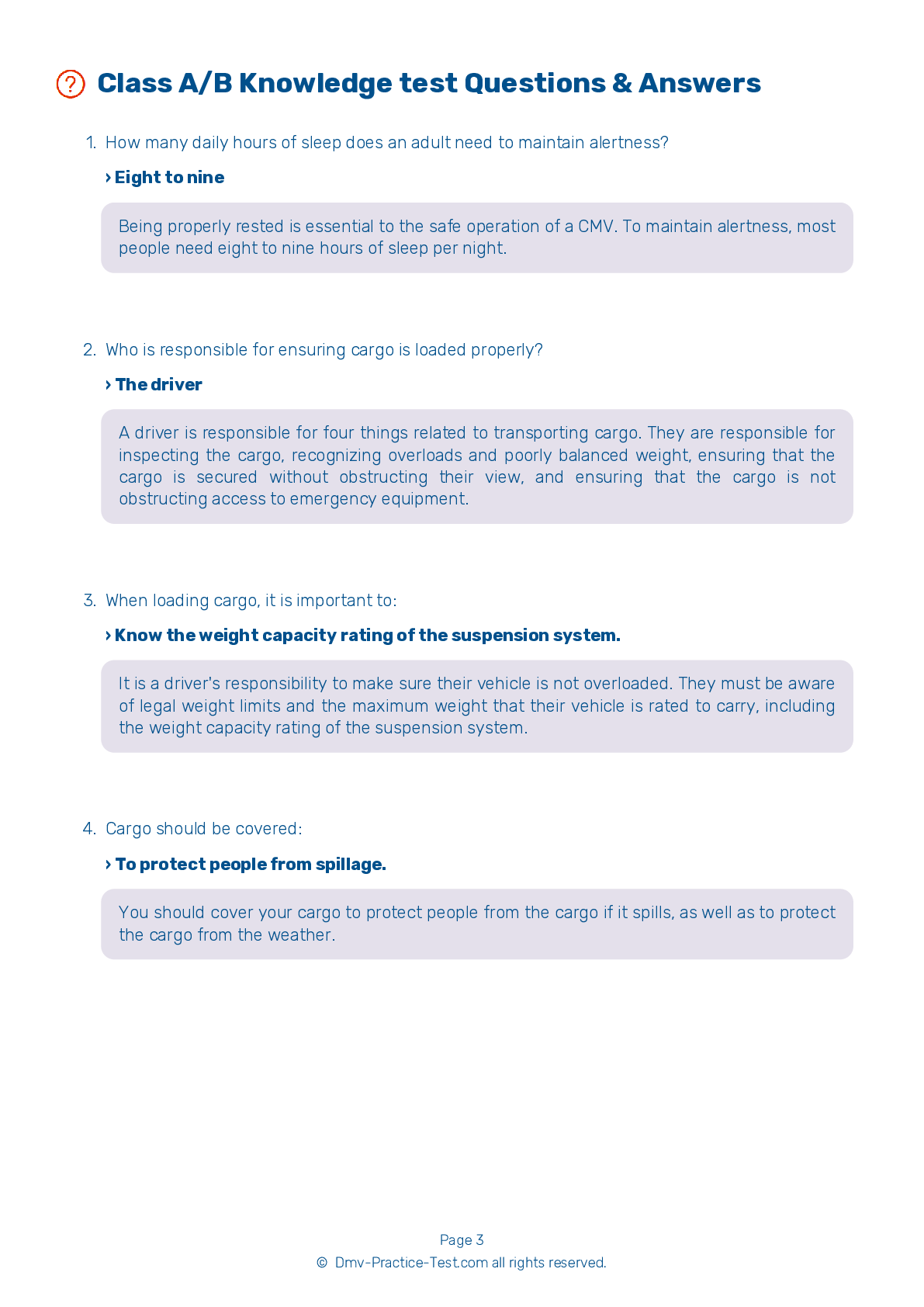Double #1
Double Triple Test | Vermont 2025 #1
Train for FREE with our Vermont CDL double triple practice test online. The official exam test consists of several obligatory parts, with all of them checking your knowledge of different blocks of road rules. If you need to obtain a VT CDL double triple license in 2025, practice as much as possible. Free sample tests published on our website will help you check and improve your knowledge and boost your grades. Please bear in mind that DMV requirements may vary from state to state.
20
16
20
1 . How many daily hours of sleep does an adult need to maintain alertness?
Four to five
Being properly rested is essential to the safe operation of a CMV. To maintain alertness, most people need eight to nine hours of sleep per night.
2 . Which part of a combination vehicle is the most likely to turn over?
In double and triple combinations, the trailer farthest from the tractor is the most vulnerable to rollover.
3 . Alcohol begins to affect the body:
Alcohol consumption impairs muscle coordination, reaction time, depth perception, vision, judgement, and inhibition. For some people, signs of impairment may begin with the first drink of alcohol. It is safest to not operate any motor vehicle after consuming alcohol in any amount.
4 . A low air pressure warning signal should activate:
In an air brake system, a low air pressure warning signal must come on if air pressure in the tanks falls below 55 psi. This warning signal may come in the form of a light, a buzzer, or a wig wag.
5 . What does a vehicle inspection report do?
Drivers may be required to submit a written vehicle inspection report at the end of each day of driving. The motor carrier must repair any items in the report that affect safety and certify on the report that repairs were either made or unnecessary.
6 . Which gas would cause concern due to a faulty exhaust system?
A leaking exhaust system can introduce carbon monoxide, which is poisonous, into the cab or sleeper berth.
7 . When driving a vehicle, rough acceleration is:
When accelerating, speed up smoothly and gradually so your vehicle does not jerk. Rough acceleration can cause mechanical damage.
2025 Vermont | Frequently Asked Questions
A CDL Class A license in Vermont is defined as a commercial driver's license that allows the holder to operate any combination of vehicles with a Gross Vehicle Weight Rating (GVWR) of 26,001 pounds or more, provided the GVWR of the vehicle(s) being towed exceeds 10,000 pounds. This typically includes tractor-trailers and truck and trailer combinations.
A Class A CDL license in Vermont allows the holder to operate vehicles such as tractor-trailers, truck and trailer combinations, tank vehicles, livestock carriers, and flatbeds. It covers any combination of vehicles with a Gross Vehicle Weight Rating (GVWR) of 26,001 pounds or more if the towed vehicle is over 10,000 pounds.
To obtain a Class A CDL license in Vermont, you must be at least 18 years old (21 for interstate driving), have a valid driver's license, pass a vision exam, and pass the General Knowledge test. You must also pass the Combination Vehicle test and a Pre-Trip Vehicle Inspection test. Lastly, you'll need to pass a skills test in the vehicle type that fits a Class A license.
In Vermont, you must be at least 18 years old to qualify for a Class A Commercial Driver's License (CDL) for intrastate driving (within Vermont only). However, you must be at least 21 years old to drive interstate (across state lines), carry hazardous materials, or transport passengers.
Specific endorsements aren't required for a Class A CDL license in Vermont, but they can provide additional driving privileges. For instance, if you plan to haul hazardous materials, transport passengers, or drive tank vehicles or double/triple trailers, you would need to obtain the corresponding endorsements by passing specific knowledge tests.
The Class A CDL skills test in Vermont has three parts: the Vehicle Inspection Test, the Basic Vehicle Control Test, and the On-Road Driving Test. The test assesses your ability to inspect your vehicle before driving, control the vehicle during different maneuvers, and drive safely in various road and traffic conditions.
Yes, there are limitations for Class A CDL license holders in Vermont. For instance, drivers under 21 can only operate within Vermont (intrastate). Also, certain endorsements like HazMat require a driver to be at least 21. Furthermore, drivers are subject to strict blood alcohol content levels and may face severe penalties for violations.
In Vermont, the written Class A CDL test is primarily offered in English. However, some locations may offer the test in other languages. It's best to contact the local DMV office directly to inquire about language options. For non-English speakers, an interpreter service may be available but it's subject to certain rules and restrictions.
Yes, you can request accommodations for the Class A CDL written test in Vermont if you have a disability. The Vermont DMV is committed to providing equal access to all services, including testing accommodations. These may include sign language interpreters, extended testing time, or tests in alternative formats. Contact your local DMV office to discuss your specific needs.
Yes, if you don't pass the Class A CDL written test in Vermont, you can retake it. However, you must wait at least one day before retesting. There is also a retesting fee that you'll need to pay each time. It's advisable to review your study materials thoroughly before attempting the test again.



